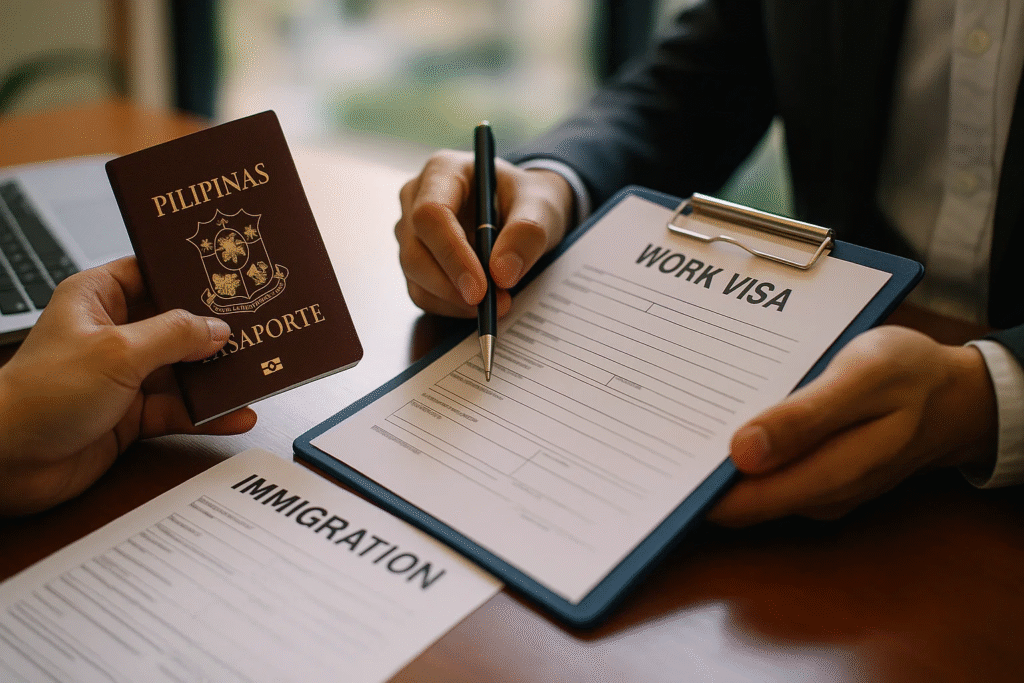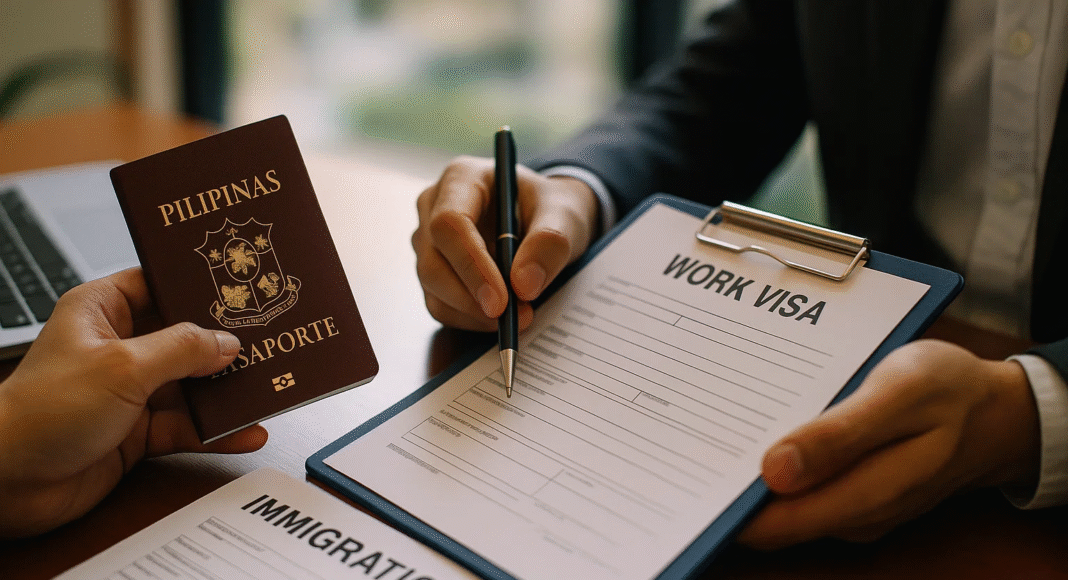Key Takeaways
- Understand the main work visa categories in the Philippines, including 9(g), 47(a)(2), PWP, and SWP, for 2026 compliance.
- Learn about updated visa fees, documentation requirements, and employer responsibilities under Philippine labor laws.
- Discover expert strategies to avoid visa delays, penalties, and ensure smooth processing for foreign employees in 2026.
The Philippines continues to emerge as one of Southeast Asia’s most dynamic business and employment destinations, drawing an increasing number of global companies, digital nomads, and foreign professionals seeking new opportunities in 2026. With a thriving economy, expanding outsourcing sector, and government initiatives promoting foreign investment, the country has become a strategic hub for skilled expatriates aiming to work and contribute to its growth. However, before foreign nationals can begin employment in the Philippines, understanding the different types of work visas and permits—and how to secure them—is essential for full compliance with immigration and labor laws.

This 2026 guide provides a detailed overview of work visa categories, permit requirements, application procedures, and the latest regulatory updates from the Department of Labor and Employment (DOLE) and the Bureau of Immigration (BI). Whether you are an employer hiring foreign talent, a professional relocating for a new role, or an investor managing operations in the country, understanding these processes ensures that all employment activities remain lawful and efficient.
In the Philippines, employment-based visa and permit systems are designed to regulate the entry and stay of foreign nationals engaging in paid work. From the widely used 9(g) Pre-Arranged Employment Visa to the Special Work Permit (SWP) and Provisional Work Permit (PWP), each type serves a specific purpose and applies to particular durations or job classifications. Additionally, obtaining an Alien Employment Permit (AEP) from DOLE remains a crucial requirement before a foreign national can legally work, making it vital to grasp both the procedural flow and documentation needed for approval.
The 2026 landscape of Philippine work authorization is also influenced by evolving global mobility trends and stricter immigration compliance standards. With government efforts to streamline visa processing and prevent illegal employment, the accuracy and completeness of every application have become more important than ever. Employers must ensure proper documentation, maintain up-to-date company accreditations, and stay informed about changes in work visa regulations, including those related to remote or hybrid work arrangements—a trend increasingly recognized by local authorities.
This comprehensive guide will cover all key aspects of work visas and permits in the Philippines, including updated 2026 requirements, eligibility criteria, step-by-step application procedures, processing times, and post-approval obligations. It also offers insights into common challenges faced by applicants and employers, practical strategies for ensuring compliance, and expert tips to avoid costly penalties or visa denials.
As the Philippines strengthens its global competitiveness and embraces a more open labor market, both local and foreign professionals can benefit from a deeper understanding of its work authorization framework. By following this complete guide, readers will gain the clarity and confidence needed to navigate the visa system effectively—ensuring a smooth, lawful, and successful employment journey in the Philippines in 2026.
Before we venture further into this article, we would like to share who we are and what we do.
About 9cv9
9cv9 is a business tech startup based in Singapore and Asia, with a strong presence all over the world.
With over nine years of startup and business experience, and being highly involved in connecting with thousands of companies and startups, the 9cv9 team has listed some important learning points in this overview of Work Visas and Permits in the Philippines for 2026: A Useful Guide.
If your company needs recruitment and headhunting services to hire top-quality employees, you can use 9cv9 headhunting and recruitment services to hire top talents and candidates. Find out more here, or send over an email to [email protected].
Or just post 1 free job posting here at 9cv9 Hiring Portal in under 10 minutes.
Work Visas and Permits in the Philippines for 2026: A Useful Guide
- Executive Overview: The 2025 Philippine Work Authorization Landscape
- Stage One: Securing the Alien Employment Permit (AEP)
- Stage Two: The 9(g) Pre-Arranged Employment Visa Application (BI Phase)
- Alternative and Expedited Work Authorization Instruments
- Financial and Administrative Considerations (2025 Fee Structure)
- Compliance, Risk Mitigation, and Expert Recommendations
1. Executive Overview: The 2025 Philippine Work Authorization Landscape
a. Introduction to the Dual Regulatory System
The Philippines has a structured process for allowing foreign nationals to work legally in the country. This process involves coordination between two main government agencies: the Department of Labor and Employment (DOLE) and the Bureau of Immigration (BI). Each agency plays a vital role in ensuring that employment opportunities for foreigners are legitimate and compliant with local laws.
Foreign professionals, investors, and skilled workers planning to work in the Philippines in 2026 must understand this dual-agency system. The process ensures that foreign workers contribute positively to the economy while protecting job opportunities for local citizens.
Understanding the Dual Regulatory Framework
Foreign nationals seeking employment in the Philippines must go through two major steps. Both the Department of Labor and Employment (DOLE) and the Bureau of Immigration (BI) have distinct but interconnected responsibilities in granting work authorization.
Department of Labor and Employment (DOLE): Alien Employment Permit (AEP)
- The Alien Employment Permit (AEP) is the first requirement for any foreign worker who wishes to engage in paid employment in the Philippines.
- It serves as proof that the position offered to the foreign national cannot be filled by a qualified Filipino citizen.
- DOLE conducts what is called a Labor Market Test (LMT), which ensures that hiring a foreign worker is necessary and that local workers are not being displaced.
- The AEP must be secured before applying for the actual work visa.
- Typical validity: one to three years, depending on the employment contract.
- Renewal is required if the contract or work continues beyond the original period.
Bureau of Immigration (BI): 9(g) Pre-Arranged Employment Visa
- Once the AEP is approved, the next step is to apply for the 9(g) Pre-Arranged Employment Visa.
- This visa provides legal residency and long-term work authorization.
- It is usually valid for the same duration as the employment contract (commonly one to three years).
- The 9(g) visa allows multiple entries and exits from the Philippines during its validity.
- It enables foreign workers to open local bank accounts, purchase property, and reside legally in the country.
- The visa is tied to a specific employer and job position. Any change in employer or role requires a new visa application.
Comparison Between AEP and 9(g) Visa
| Criteria | Alien Employment Permit (AEP) | 9(g) Pre-Arranged Employment Visa |
|---|---|---|
| Issuing Authority | Department of Labor and Employment (DOLE) | Bureau of Immigration (BI) |
| Primary Purpose | Authorizes foreign nationals to work in a specific job | Grants legal residency and work authorization |
| Validity Period | 1 to 3 years | 1 to 3 years (aligned with contract) |
| Labor Market Test Required | Yes | No (relies on AEP approval) |
| Renewal Required | Yes, if work continues | Yes, upon contract renewal |
| Transferable to Other Employer | No, new AEP required | No, new 9(g) required |
| Rights Granted | Permission to work | Residency, re-entry rights, banking, property purchase |
Key Steps to Obtain a Work Visa and Permit in the Philippines
- Job Offer and Contract Preparation
- The employer provides a formal job offer and employment contract outlining job duties, duration, and compensation.
- Application for Alien Employment Permit (AEP)
- The company files the AEP application with DOLE.
- DOLE conducts the Labor Market Test.
- Once approved, the AEP certificate is issued.
- Application for 9(g) Visa at the Bureau of Immigration
- Submit the approved AEP along with other required documents.
- BI reviews the application and issues the 9(g) visa.
- Issuance of Work Visa and Residency Documentation
- Once approved, the foreign employee receives the visa and Alien Certificate of Registration (ACR I-Card), which serves as proof of legal residence.
Benefits of the 9(g) Visa
Foreign nationals holding the 9(g) visa enjoy several privileges that make living and working in the Philippines more convenient:
- Legal authorization to work in the country.
- Freedom to travel in and out of the Philippines without restrictions.
- Eligibility to open bank accounts, rent or purchase property, and enroll in local health insurance programs.
- Ability to renew the visa based on continued employment.
Important Considerations for Employers and Employees
- The AEP and 9(g) visa are employer-specific. A new application is mandatory when changing jobs.
- Employers must ensure that all foreign workers maintain valid permits and visas to avoid legal penalties.
- Foreign employees should keep copies of all relevant documents, including contracts, permits, and identification cards.
- The processing time varies depending on the agency’s workload but usually takes several weeks.
Overview Chart: Philippine Work Visa and Permit Process
| Step | Responsible Agency | Main Purpose | Typical Duration |
|---|---|---|---|
| Step 1: Job Offer | Employer | Prepare contract and requirements | 1–2 weeks |
| Step 2: AEP Application | DOLE | Approve employment for foreign nationals | 2–4 weeks |
| Step 3: 9(g) Visa Application | BI | Grant residency and work authorization | 4–6 weeks |
| Step 4: Visa Issuance | BI | Release visa and residency documents | 1 week |
Conclusion
Navigating the Philippine work visa and permit process in 2026 requires understanding the collaboration between DOLE and the Bureau of Immigration. Each step ensures that both foreign professionals and local workers benefit fairly from employment opportunities. For foreign nationals planning to work in the Philippines, compliance with these regulations guarantees a smooth and lawful employment journey, supporting both professional growth and long-term residency stability.
b. Salient Regulatory Updates for 2025: Focus on DOLE DO 248-25
The work visa and permit landscape in the Philippines continues to evolve as the government seeks to balance the inflow of foreign talent with the protection of local employment. In 2025, the Department of Labor and Employment (DOLE) introduced Department Order (DO) No. 248, series of 2025, which brought significant changes to how companies hire and manage foreign employees. These updates aim to simplify certain administrative processes while strengthening requirements that ensure Filipino workers remain a top priority in the labor market.
For 2026, employers and foreign professionals must understand the implications of these new regulations. Compliance with DO 248-25 and its supplementary guidelines (DO 248-A-251) is now essential for companies planning to employ foreign nationals in the Philippines.
Purpose and Impact of DOLE Department Order 248-25
The main objective of DO 248-25 is to create a more transparent and efficient system for processing Alien Employment Permits (AEPs), while also ensuring that the employment of foreign workers benefits the local economy. The Department Order seeks to maintain a fair balance between foreign expertise and local talent development.
The regulation introduces two main goals:
- To simplify procedures and reduce unnecessary administrative delays in obtaining AEPs.
- To reinforce accountability among employers by requiring stronger justification for hiring foreign workers.
Key Regulatory Changes Introduced in DO 248-25
The 2025 Department Order introduces several important updates that will continue to shape the 2026 work permit environment. Employers and foreign professionals should take note of the following changes:
Revised Alien Employment Permit (AEP) Filing Timeline
- Companies must now follow a stricter timeline when filing for AEPs.
- Late submissions or incomplete documentation can result in penalties or delays in visa approval.
- The updated schedule ensures that DOLE can process applications more efficiently and prevent backlogs.
Simplification of the Labor Market Test (LMT)
- The new framework streamlines the process of verifying that no qualified Filipino workers are available for the position being offered to a foreign national.
- DOLE now applies clearer guidelines for labor market testing, making the process faster and more transparent.
- Employers are still required to demonstrate the necessity of hiring foreign workers, but repetitive documentation has been reduced.
Introduction of the Understudy Training or Skills Development Program (UTP/SDP)
- One of the most significant new requirements is the inclusion of Understudy Training or Skills Development Programs.
- These programs are designed to ensure that Filipino employees receive on-the-job training from their foreign counterparts.
- The goal is to transfer knowledge and technical skills to local staff, strengthening the long-term competitiveness of the Filipino workforce.
- Certain industries and companies, especially those in manufacturing, information technology, and engineering, must now implement these training programs as part of their compliance process.
Summary of Key Changes under DO 248-25
| Regulatory Area | Previous Practice | New 2025–2026 Requirements | Impact on Employers |
|---|---|---|---|
| AEP Filing Timeline | Flexible, with variable processing schedules | Standardized filing deadlines with strict documentation requirements | Faster processing but less tolerance for delays |
| Labor Market Test (LMT) | Lengthy and repetitive documentation | Streamlined process with defined verification steps | Easier compliance and quicker approvals |
| Understudy Training Program | Not mandatory for most companies | Compulsory for designated sectors and roles | Promotes skills transfer and local workforce development |
| Employer Accountability | Basic justification for foreign hires | Stronger proof of necessity and training plans required | Higher compliance standards for employers |
Implications for Employers and Foreign Workers in 2026
For Employers
- Businesses employing foreign nationals must review their internal hiring procedures to align with DO 248-25.
- Companies must allocate resources for compliance programs, including the development of training and understudy initiatives.
- Proper documentation and adherence to timelines will be critical to avoid penalties or application rejections.
For Foreign Workers
- Applicants must ensure that their employers are fully compliant with DOLE’s requirements before applying for a work permit.
- They may be required to participate in skill-transfer programs as part of their employment.
- Understanding the link between the AEP and the Bureau of Immigration’s 9(g) Visa remains essential to maintaining legal work and residency status.
Compliance Process Flow Under the 2025–2026 DOLE Framework
| Step | Activity | Responsible Party | Key Objective |
|---|---|---|---|
| Step 1 | Job Offer and Contract Preparation | Employer | Establish legal employment terms |
| Step 2 | Conduct Labor Market Test | DOLE & Employer | Verify unavailability of qualified local candidates |
| Step 3 | File AEP Application | Employer | Obtain work authorization approval |
| Step 4 | Implement Understudy Program | Employer & Foreign Worker | Ensure skills transfer to Filipino employees |
| Step 5 | Apply for 9(g) Visa | Employer & Bureau of Immigration | Obtain legal residency and work visa |
Conclusion
The introduction of DOLE Department Order 248-25 marks a major step forward in the Philippines’ efforts to create a fair, transparent, and efficient labor environment for both local and foreign workers. For 2026, the emphasis lies on reducing red tape while ensuring meaningful knowledge transfer from foreign professionals to Filipino workers.
Employers planning to hire foreign nationals should act promptly to align their internal policies with the latest DOLE regulations. Proper understanding and compliance will not only speed up the approval process but also foster sustainable partnerships between global expertise and local talent in the Philippines.
c. Causal Relationship and Strategic Imperative: The Role of Interim Permits
In the Philippines, one of the main challenges faced by companies hiring foreign workers is the long processing time for employment authorization. The entire process for obtaining a 9(g) Pre-Arranged Employment Visa, including the Alien Employment Permit (AEP) phase, can take anywhere from two to three months. For many organizations, this waiting period can cause significant delays in project schedules and overall business operations, especially when a foreign professional’s expertise is urgently needed.
To address this issue, the government provides an interim solution known as the Provisional Work Permit (PWP). This permit serves as a temporary authorization that allows a foreign national to start working legally while waiting for their AEP and 9(g) visa to be fully approved.
The Role and Strategic Value of the Provisional Work Permit (PWP)
The Provisional Work Permit is issued by the Bureau of Immigration (BI) and is designed to help companies maintain operational continuity. It bridges the gap between the start of the AEP application and the final visa issuance. Rather than pausing business activities for several months, employers can use the PWP to onboard essential foreign staff immediately.
Key Features of the Provisional Work Permit (PWP)
- Issuing Authority: Bureau of Immigration (BI)
- Purpose: Allows foreign nationals to start working while their long-term visa and AEP are being processed
- Validity Period: Generally valid for three months or until the 9(g) visa is approved, whichever comes first
- Processing Time: Typically issued within one to two weeks after submission
- Eligibility: Available to foreign nationals who have already filed for an Alien Employment Permit (AEP) with the Department of Labor and Employment (DOLE)
Why the Provisional Work Permit (PWP) is a Strategic Necessity
The PWP is not merely a temporary convenience—it plays a strategic role in ensuring legal compliance and business efficiency. Companies that require specialized foreign expertise, such as in engineering, finance, or technology, often cannot afford to wait several months for visa approvals. The PWP enables them to remain compliant while keeping their operations running smoothly.
Benefits for Employers
- Reduces Downtime: Allows immediate work deployment, preventing project delays and productivity loss.
- Ensures Compliance: Provides legal protection against penalties for employing foreigners without authorization.
- Supports Business Continuity: Maintains the company’s momentum in operations, especially in time-sensitive projects.
- Facilitates Efficient Onboarding: Helps HR and compliance teams manage international hires smoothly while other paperwork is processed.
Benefits for Foreign Workers
- Faster Employment Start: Allows foreign professionals to begin working legally without long waiting times.
- Seamless Transition: The PWP remains valid until the issuance of the 9(g) visa, ensuring no employment gaps.
- Legal Security: Provides formal authorization to work, reducing risks of immigration violations.
Typical Processing Timeline of Work Authorization Documents
| Stage | Document | Issuing Authority | Average Processing Time | Purpose |
|---|---|---|---|---|
| Step 1 | Alien Employment Permit (AEP) | Department of Labor and Employment (DOLE) | 2–3 weeks | Authorizes employment of foreign nationals |
| Step 2 | Provisional Work Permit (PWP) | Bureau of Immigration (BI) | 1–2 weeks | Grants temporary permission to work |
| Step 3 | 9(g) Pre-Arranged Employment Visa | Bureau of Immigration (BI) | 6–8 weeks | Grants long-term work and residency rights |
This sequence shows how the PWP serves as an interim step, filling the gap between the AEP application and the 9(g) visa approval. By obtaining the PWP early, companies can maintain full compliance with Philippine labor and immigration laws.
Strategic Workflow for Employers Managing Foreign Workers
| Action | Responsible Party | Timeline | Objective |
|---|---|---|---|
| File AEP Application | Employer & DOLE | Week 1–3 | Begin employment authorization process |
| Apply for PWP | Employer & BI | Week 2 | Obtain temporary work permit for immediate deployment |
| Begin Work | Foreign Employee | Week 2–3 | Start legal employment under PWP |
| Apply for 9(g) Visa | Employer & BI | Week 4–10 | Secure long-term visa and residency |
| Transition to Full Visa | BI | Week 10–12 | Convert temporary permit to full authorization |
Operational Significance of Using a PWP
For many organizations, particularly multinational corporations, infrastructure firms, and tech companies, using a Provisional Work Permit is a practical necessity. The PWP ensures that foreign professionals can start contributing to their projects without legal or administrative setbacks. It also demonstrates the employer’s commitment to following proper procedures under Philippine labor laws.
From a strategic standpoint, securing a PWP offers the following advantages:
- It minimizes disruptions in global project timelines.
- It supports faster onboarding of foreign technical experts and executives.
- It ensures compliance with strict employment regulations.
- It reflects corporate responsibility in adhering to local workforce policies.
Conclusion
In 2026, the Provisional Work Permit remains a vital part of the Philippine work visa framework. While the AEP and 9(g) visa processes can take several months, the PWP provides a legal and efficient solution for employers needing immediate foreign workforce deployment. Companies that recognize its importance and integrate it into their compliance strategy can maintain productivity, avoid delays, and ensure adherence to Philippine immigration and employment laws.
For both employers and foreign professionals, understanding the role of the PWP is key to a smooth and lawful employment journey in the Philippines.
2. Stage One: Securing the Alien Employment Permit (AEP)
a. The Legal Mandate and Process Ownership
The Alien Employment Permit (AEP) is one of the most essential documents for foreign nationals who wish to work legally in the Philippines. It serves as the foundation for obtaining a 9(g) Pre-Arranged Employment Visa, which grants long-term residency and employment rights in the country.
The main purpose of the AEP is to ensure that the hiring of a foreign professional does not take away job opportunities from qualified Filipino citizens. The Department of Labor and Employment (DOLE) regulates this process, making sure that the employment of foreigners benefits the local economy while maintaining fair competition in the labor market.
Legal Framework and Purpose of the AEP
The Alien Employment Permit functions as an official approval issued by DOLE to confirm that a foreign national is allowed to work in a specific position within a registered company in the Philippines. It acts as a safeguard, protecting the interests of Filipino workers by ensuring that foreign hires only occupy roles that require unique expertise not readily available locally.
The key objectives of the AEP are:
- To verify that hiring a foreign worker is justified and necessary for business operations.
- To maintain compliance with Philippine labor laws and immigration policies.
- To regulate the entry of foreign professionals into the local workforce.
- To support the government’s labor market policies that prioritize Filipino citizens.
Responsibility and Application Ownership
The responsibility for obtaining the AEP rests entirely with the sponsoring employer. Foreign workers are not permitted to file their applications independently. The employer must initiate, prepare, and submit all required documents to DOLE on behalf of the foreign employee.
This ensures that companies remain accountable for their hiring practices and comply with all local labor regulations. Employers must also provide evidence that no qualified Filipino candidate was available for the position before offering it to a foreign applicant.
Step-by-Step Process of Applying for an Alien Employment Permit (AEP)
| Step | Description | Responsible Party | Average Processing Time |
|---|---|---|---|
| 1 | Job offer and contract preparation | Employer | 1 week |
| 2 | Filing of AEP application at DOLE | Employer | 1–2 days |
| 3 | Publication of job vacancy for Labor Market Test | DOLE | 10 working days |
| 4 | Evaluation of submitted documents | DOLE | 5 working days |
| 5 | Issuance of AEP certificate | DOLE | Within 15 working days after payment |
The total processing time for an AEP usually ranges from two to three weeks, depending on the completeness of documents and the volume of applications.
Required Documents for AEP Application
To apply for an AEP, the employer must prepare and submit several supporting documents. These typically include:
- Duly accomplished AEP application form
- Valid passport with visa or stay permit
- Photocopy of the employment contract or appointment letter
- Proof of business registration (SEC or DTI certificate)
- Company’s latest financial statement or business permit
- Justification letter explaining the need to hire a foreign worker
- Two colored ID photos (2×2 size)
DOLE may request additional documents if further verification is required.
Key Compliance Responsibilities of Employers
Employers play a central role in ensuring the legal employment of foreign nationals. The following are the major compliance obligations:
- File the AEP on behalf of the employee. The foreign worker cannot apply independently.
- Pay the required government fees and ensure that the application is processed within the designated timeline.
- Conduct the Labor Market Test (LMT) to confirm that no qualified Filipino worker is available for the job.
- Renew the AEP before its expiration if the employee’s contract continues.
- Report any changes in employment status, position, or company name to DOLE.
Comparison of Employer and Employee Responsibilities in the AEP Process
| Responsibility Area | Employer | Foreign Employee |
|---|---|---|
| Application Filing | Submit AEP application to DOLE | Provide necessary personal documents |
| Payment of Fees | Pay all government and processing charges | None |
| Compliance Monitoring | Ensure ongoing adherence to labor laws | Maintain valid passport and visa |
| Renewal or Termination | Apply for renewal or notify DOLE of termination | Surrender AEP upon employment termination |
This division of responsibility ensures accountability and proper coordination between employers and foreign workers during the entire employment authorization process.
Purpose and Impact of the AEP in 2026
The Alien Employment Permit is more than a formality—it is a regulatory mechanism that helps the Philippines balance the benefits of foreign talent with the development of its local workforce. As the country continues to attract foreign investment in 2026, the AEP system ensures that the hiring of foreign professionals remains fair, transparent, and compliant with national labor policies.
For employers, understanding and fulfilling the AEP requirements helps avoid costly legal issues or hiring delays. For foreign nationals, holding an AEP is the first step toward obtaining a 9(g) Work Visa and starting a legally recognized professional journey in the Philippines.
Conclusion
In the Philippine employment system, the Alien Employment Permit serves as the gateway to lawful foreign employment. By ensuring that employers follow due process and that foreign hires meet all qualifications, DOLE helps protect both local and international workforce interests. In 2026, securing an AEP remains a critical first step for any foreign national who wishes to work legally, professionally, and sustainably in the Philippines.
b. Critical 2025 Compliance: Detailed Analysis of DO 248-25
Foreign professionals planning to work in the Philippines in 2026 need to understand the country’s evolving employment regulations. The Department of Labor and Employment (DOLE) has introduced new compliance updates under Department Order (DO) 248-25 that directly affect how companies hire foreign nationals and how work permits are processed. This guide explains these updates in simple and clear language, helping employers and expats navigate the requirements effectively.
Key Updates under DO 248-25 for 2025–2026
The revised rules aim to make the process more transparent and efficient while ensuring that Filipino workers remain a priority in the labor market. Below are the main highlights:
Adjustment of Alien Employment Permit (AEP) Filing Period
The AEP is a key document for any foreign professional working in the Philippines. Under the new rules:
- The filing period has changed from 10 working days to 15 calendar days after signing the employment contract.
- This means weekends and holidays are now included in the 15-day count.
- Employers and foreign workers must act faster to prepare and submit all required paperwork within the shortened timeline.
Practical Implications
- Companies need better coordination between HR departments and expats to meet deadlines.
- Delayed submission can lead to penalties or rejection of the permit application.
Comparison Table: Old vs. New AEP Filing Rules
| Requirement | Previous Rule | New Rule (DO 248-25) | Key Impact |
|---|---|---|---|
| Filing Deadline | Within 10 working days | Within 15 calendar days | Weekends and holidays now counted |
| Documentation | Standard AEP forms | Enhanced verification and employer coordination | Faster document processing required |
| Employer Role | Submit through HR | Must coordinate directly with DOLE | Ensures accountability |
Revised Labor Market Test (LMT)
The Labor Market Test ensures that hiring a foreign national will not displace qualified local workers. DO 248-25 refines this process to make it more structured and transparent.
Key Updates
- Employers must publish job vacancies in a national newspaper before applying for an AEP.
- A notarized affidavit must be submitted, confirming that no qualified Filipino applicants were available for the role.
- Employers are now encouraged to post job openings on PhilJobNet (the government’s official job portal) and with Public Employment Service Offices (PESO) or Job Placement Offices (JPO).
Purpose of the LMT Revision
- To ensure local workers are given first priority for available jobs.
- To promote transparency and fairness in hiring foreign professionals.
- To reduce redundant paperwork and simplify validation through digital channels.
LMT Process Overview (2026)
| Step | Action | Responsible Party | Required Document |
|---|---|---|---|
| 1 | Publish job vacancy in a national newspaper | Employer | Newspaper posting copy |
| 2 | Wait for potential local applicants | Employer | Screening records |
| 3 | Prepare notarized affidavit confirming no qualified locals applied | Employer | Affidavit of No Local Applicants |
| 4 | Optionally post on PhilJobNet and PESO/JPO | Employer | Screenshot or posting proof |
Future Direction
The government may soon prioritize digital posting as the main LMT validation method. Companies that start adapting early to online systems will demonstrate better compliance and operational efficiency.
Mandatory Understudy Training or Skills Development Program (UTP/SDP)
A major change under DO 248-25 is the requirement for some employers to submit a training or skills development plan when hiring foreign nationals.
Who Must Comply
- Businesses registered under the Foreign Investment Act (FIA) and receiving tax incentives or fiscal benefits.
- Companies operating in public utilities or critical infrastructure sectors such as energy, water, telecommunications, and transport.
Purpose of the UTP/SDP Requirement
- To ensure technology and knowledge transfer from foreign experts to local employees.
- To strengthen Filipino workforce capabilities through structured mentorship and training.
Program Expectations
- Companies must outline a clear roadmap for training local understudies.
- The plan should specify skills to be transferred, training duration, and measurable learning outcomes.
- A poorly designed or missing plan could result in AEP application denial.
UTP/SDP Evaluation Matrix
| Evaluation Criteria | Description | Impact on AEP Approval |
|---|---|---|
| Clarity of Training Objectives | Defines how skills will be transferred | High |
| Number of Understudies | Specifies the number of Filipino employees trained | Medium |
| Training Timeline | Duration and milestones of the program | Medium |
| Documentation and Reporting | Records of progress and completion | High |
| Relevance to Business Operations | Connection between training and company role | High |
Practical Implications for Employers and Foreign Workers
- Companies must review internal policies to align with the new DOLE requirements.
- Early preparation of LMT, UTP/SDP plans, and AEP applications will prevent delays.
- Employers who fail to comply risk losing their ability to employ foreign professionals.
Strategic Recommendations
- Develop a compliance checklist to track AEP filing and LMT publication timelines.
- Adopt digital tools to manage job postings and document submissions.
- Establish an HR training framework for handling UTP/SDP program development.
Conclusion
As the Philippines strengthens its labor policies for 2026, understanding the new DOLE regulations is vital for both employers and expatriates. The updates under DO 248-25 focus on promoting local employment, enhancing transparency, and fostering skill development. Employers who proactively adapt to these rules not only ensure legal compliance but also contribute to sustainable workforce growth and stronger business credibility in the Philippine market.
c. AEP Processing and Validity
Foreign nationals planning to work in the Philippines in 2026 must understand the latest policies regarding the Alien Employment Permit (AEP). This document is a primary requirement for foreign professionals who wish to work legally in the country. The Department of Labor and Employment (DOLE) oversees the entire AEP process, ensuring that every step aligns with national labor standards and supports fair employment practices.
AEP Application Process and Timelines
The processing of an Alien Employment Permit follows a specific timeframe to ensure consistency and transparency. According to the latest DOLE regulations, the official processing period begins once the application fee has been paid.
Key Details:
- The processing duration is set at 15 working days from the date of payment.
- Walk-in follow-ups or personal visits to DOLE offices are no longer allowed.
- All communications, submissions, and status updates must go through official online or designated channels.
- The accuracy and completeness of submitted documents are crucial to meeting the 15-day processing timeline. Any errors or missing information can delay the approval process.
AEP Processing Overview (2026)
| Step | Process Description | Responsible Party | Estimated Duration |
|---|---|---|---|
| 1 | Preparation of documents and payment of AEP fee | Employer/Foreign Applicant | 1–3 days |
| 2 | Submission through DOLE official channels | Employer/Applicant | Same day |
| 3 | Document review and verification by DOLE | DOLE Processing Unit | 10–12 days |
| 4 | Approval and release of AEP | DOLE Regional Office | Within 15 working days total |
AEP Validity Period and Renewal Terms
Once the Alien Employment Permit is approved, it becomes valid for the same period as the employment contract of the foreign national. This ensures that the worker’s stay and employment rights are legally synchronized with their contract duration.
Key Validity Points:
- The AEP is typically issued for 1, 2, or 3 years, depending on the length of the employee’s contract.
- Employers and foreign workers must apply for renewal before the expiration date to avoid lapses in legal status.
- Renewal applications must follow the same submission and processing procedures as new applications.
AEP Validity Matrix
| Employment Contract Duration | AEP Validity Period | Renewal Requirement |
|---|---|---|
| 1 year or less | 1 year | Renewal before expiry |
| 2 years | 2 years | Renewal before expiry |
| 3 years or more | 3 years (maximum) | Renewal every 3 years |
Best Practices to Avoid Delays in AEP Approval
To ensure smooth processing, both employers and foreign applicants should take the following steps:
- Prepare all documents carefully before submission, including employment contracts, identification papers, and supporting certifications.
- Double-check information such as names, addresses, and employment details for accuracy.
- Submit documents digitally through DOLE’s authorized online systems rather than manual or in-person processes.
- Keep digital copies of all receipts and correspondence for future reference and compliance audits.
Key Insights for 2026 Compliance
The Philippines is moving toward a more digital and transparent permit system. By eliminating walk-ins and enforcing strict adherence to documentation accuracy, DOLE aims to make the AEP process faster and more efficient for both local employers and foreign professionals.
Employers that maintain compliance through timely submissions and proper record-keeping will not only ensure legal employment status for their foreign hires but also build a strong reputation for reliability and adherence to national labor standards.
In conclusion, understanding the new structure of AEP processing and validity is essential for companies and expats alike. Proper planning, accuracy, and proactive communication remain the most effective ways to secure timely permit approval and maintain full compliance under the Philippines’ evolving labor system in 2026.
3. Stage Two: The 9(g) Pre-Arranged Employment Visa Application (BI Phase)
a. Corporate Sponsorship and Financial Capacity Requirements
For foreign professionals planning to work in the Philippines in 2026, understanding the 9(g) Pre-Arranged Employment Visa process is essential. This stage follows the successful acquisition of the Alien Employment Permit (AEP) from the Department of Labor and Employment (DOLE). Once the AEP is granted, the next step involves applying for the work visa proper through the Bureau of Immigration (BI).
This process is not only about the applicant’s qualifications but also centers on the employer’s financial capacity and legal compliance. The BI evaluates whether the company sponsoring the foreign worker is capable of supporting foreign employment while adhering to national regulations designed to protect local workers.
Corporate Sponsorship and Legal Compliance Requirements
The Bureau of Immigration ensures that every company hiring a foreign professional meets specific business and financial standards. This serves to confirm that foreign nationals are being hired by legitimate, stable, and compliant organizations.
Key Sponsorship Requirements:
- The sponsoring company must be legally registered with the Securities and Exchange Commission (SEC) for corporations or with the Department of Trade and Industry (DTI) for single proprietorships.
- The company must be in good financial standing, demonstrating the ability to sustain the foreign employee’s position and contribute to the local economy.
- Documentation showing updated financial statements, business permits, and proof of paid-up capital is mandatory during the visa application process.
Employer Registration and Financial Capacity Overview (2026)
| Category | Registering Authority | Financial Proof Required | Remarks |
|---|---|---|---|
| Corporations | Securities and Exchange Commission (SEC) | Audited financial statements, paid-up capital certification | Must maintain active corporate registration |
| Single Proprietorships | Department of Trade and Industry (DTI) | Business permit, bank proof of financial capacity | Must be locally registered and compliant |
Capitalization Requirements for Foreign-Owned Enterprises
Capitalization plays a major role in determining eligibility for the 9(g) visa sponsorship. The government imposes a minimum investment threshold to ensure that foreign companies hiring non-Filipinos have a tangible contribution to the economy.
Capital Requirements for 9(g) Visa Sponsorship (2026)
| Type of Enterprise | Minimum Paid-Up Capital | Conditions | Notes |
|---|---|---|---|
| Foreign-Owned Domestic Market Enterprise (DME) | US$200,000 | Standard requirement | Applies to most foreign companies |
| DME using Advanced Technology | US$100,000 | Must demonstrate innovation or advanced tech use | Subject to government validation |
| DME employing at least 50 Filipino workers | US$100,000 | Must show proof of 50 active Filipino employees | Employment must be verifiable before application |
These thresholds ensure that only credible and financially capable businesses are granted sponsorship privileges. Smaller enterprises planning to operate with reduced capital must meet the employment requirement or technological innovation condition before they can file the 9(g) visa application.
Strategic Visa Planning for Employers and Investors
Employers are advised to align their corporate capitalization, local employment goals, and visa strategy early in their business setup process. The Bureau of Immigration cross-checks company capital with hiring records, ensuring that businesses genuinely contribute to the Philippine labor market.
Practical Recommendations for Employers:
- Establish a clear corporate structure before hiring foreign staff to ensure compliance with SEC or DTI registration requirements.
- Maintain accurate financial records and ensure that all company documents are updated before submitting the visa application.
- For companies with limited investment capital, consider hiring at least 50 Filipino employees to qualify for reduced capital requirements.
- Prepare an immigration and employment strategy that integrates financial, legal, and operational plans to support sustainable business operations.
Key Takeaway for 2026 Applicants
The 9(g) Pre-Arranged Employment Visa process in the Philippines emphasizes the relationship between a company’s financial strength and its ability to hire foreign professionals. By ensuring proper capitalization, transparent documentation, and a strong local hiring commitment, employers can streamline their visa applications and avoid costly delays.
Foreign investors and corporate employers that proactively meet these requirements not only secure the right to employ international talent but also position themselves as trustworthy contributors to the Philippines’ long-term economic growth.
b. Detailed 9(g) Documentary Requirements (Post-AEP)
Applying for a 9(g) Pre-Arranged Employment Visa is a key step for foreign professionals who want to legally work in the Philippines. After successfully obtaining the Alien Employment Permit (AEP) from the Department of Labor and Employment (DOLE), the next stage is submitting a complete application package to the Bureau of Immigration (BI). This process requires strict compliance with documentation standards to ensure a smooth and timely approval.
The Bureau of Immigration carefully reviews each document to confirm the applicant’s identity, the employer’s legitimacy, and the authenticity of the job position. Submitting incomplete or inaccurate documents may result in processing delays or even visa rejection.
Key 9(g) Visa Documentation Requirements (Post-AEP Approval)
To maintain transparency and efficiency, both the employer and the foreign national must prepare a comprehensive set of documents before filing the 9(g) visa application. Each requirement plays a specific role in validating the applicant’s qualifications and the employer’s legal capacity.
Detailed List of 9(g) Visa Documentary Requirements (2026)
| Requirement | Description | Purpose |
|---|---|---|
| Consolidated General Application Form (CGAF) | A standard BI application form that must be accurately filled and signed by both employer and employee. | Serves as the official record for the visa request. |
| Valid Passport | Must be valid for at least six months beyond the intended stay in the Philippines. | Confirms the applicant’s nationality and eligibility for visa issuance. |
| Approved Alien Employment Permit (AEP) | Original and photocopy of the DOLE-issued AEP with the official receipt. | Verifies that the foreign national is legally permitted to work in the Philippines. |
| Employment Contract | Original or certified true copy showing job title, salary, and duration of employment. | Confirms that the employment offer is genuine and meets legal requirements. |
| Corporate Registration Documents | SEC or DTI registration, local Mayor’s Business Permit, and latest General Information Sheet (GIS). | Establishes that the employer is a legally operating entity in the Philippines. |
| Medical Certificate (DFA Form 11) | Required for applicants seeking an extended visa validity period. | Ensures the applicant meets the health standards for long-term residency. |
| Police Clearance | Must be apostilled or legalized if issued from abroad. | Confirms that the applicant has no criminal record that may disqualify them from entry. |
| Secretary’s Certificate (if applicable) | Required for individuals employed in elective or board-level positions. | Validates the appointment or election to the designated corporate role. |
Procedural and Attendance Requirements
Beyond paperwork, the Bureau of Immigration requires the personal presence of the foreign national during certain stages of the application process. This ensures identity verification and compliance with immigration regulations.
Step-by-Step BI Process Overview (2026)
| Step | Activity | Description |
|---|---|---|
| Step 1 | Submission of Complete Documents | All required forms and attachments must be submitted to the BI for verification. |
| Step 2 | Review and Pre-Evaluation | Immigration officers assess the authenticity and completeness of the documents. |
| Step 3 | BI Interview | The applicant may be asked to attend an interview to confirm employment details and background. |
| Step 4 | Biometric Data Capture | Fingerprints, photographs, and signatures are taken for record purposes. |
| Step 5 | Visa Approval and Issuance | Once approved, the visa is stamped in the passport, and the applicant can begin formal employment. |
Important Notes for Employers and Applicants
- Ensure that all corporate and personal documents are notarized or certified true copies before submission.
- Always double-check the validity period of the passport and AEP, as expired documents automatically delay the process.
- Maintain clear communication with the Bureau of Immigration for any additional requirements or clarifications.
- Keep scanned copies of all submitted paperwork for record and renewal purposes.
Summary Table: Key Responsibilities in the 9(g) Visa Application
| Party Responsible | Main Tasks | Required Documents |
|---|---|---|
| Employer | Sponsorship, document preparation, coordination with BI | SEC/DTI registration, business permits, AEP copy, employment contract |
| Foreign Worker | Attend interviews, submit personal documents, comply with BI processes | Passport, police clearance, medical certificate, application form |
Conclusion
The 9(g) Pre-Arranged Employment Visa application in the Philippines requires both accuracy and coordination between the employer and the foreign professional. For 2026, the Bureau of Immigration continues to prioritize proper documentation, identity verification, and employer accountability to maintain a transparent work authorization system.
By preparing complete and compliant documents early, applicants and companies can significantly reduce processing delays and ensure a smoother transition into lawful employment within the country’s growing business environment.
c. Post-Approval and Annual Reporting Obligations
After successfully obtaining the 9(g) Pre-Arranged Employment Visa, the foreign professional officially gains authorization to live and work in the Philippines. However, the process does not end with the visa approval. There are important post-approval and ongoing compliance responsibilities that every visa holder must observe to maintain legal status in the country. These obligations are designed to ensure continuous monitoring, lawful employment, and proper record-keeping of foreign nationals by the Bureau of Immigration (BI).
Post-Approval Documentation and Identification
Once the 9(g) visa is approved and stamped in the passport, the foreign national is issued an Alien Certificate of Registration Identity Card (ACR I-Card). This card acts as the official identification document for all registered foreign residents in the Philippines.
Key Information About the ACR I-Card (2026)
| Category | Details | Importance |
|---|---|---|
| Issuing Authority | Bureau of Immigration (BI) | Confirms lawful residence of a foreign national |
| Purpose | Serves as an identification and registration card | Required for all legal transactions, banking, and travel within the country |
| Validity Period | Matches the approved visa duration (usually 1–3 years) | Must be renewed alongside the visa extension |
| Required for | Foreign nationals with valid long-term visas such as 9(g), 13(a), or SRRV | Ensures immigration record consistency and monitoring |
The ACR I-Card contains essential personal and immigration data, such as visa type, date of issuance, and validity. It is a digital ID with biometric security features, ensuring accuracy and preventing fraudulent identity use.
Mandatory Annual Reporting for Foreign Nationals
One of the most important yet often neglected obligations for foreign residents is the Mandatory Annual Reporting, a legal requirement under the Alien Registration Act of 1950. Every foreign national holding an ACR I-Card—including those with 9(g) employment visas—must personally appear before the Bureau of Immigration within the first 60 days of each calendar year.
Annual Reporting Requirements and Timeline (2026)
| Requirement | Details | Reporting Period |
|---|---|---|
| Who Must Report | All registered foreign nationals with valid ACR I-Cards | January 1 – March 1 |
| Where to Report | Bureau of Immigration Main Office or Authorized Field Offices | Nationwide BI centers |
| What to Bring | Original ACR I-Card, valid passport, and payment of processing fee | Must be personally presented |
| Frequency | Once per year | Annual compliance activity |
Key Objectives of the Annual Reporting:
- To verify the continued residence and employment of foreign nationals in the Philippines.
- To update the Bureau of Immigration’s database for national security and labor monitoring.
- To confirm that all visa holders remain compliant with Philippine immigration and employment laws.
Penalties for Non-Compliance
Failure to complete the mandatory reporting may lead to serious administrative penalties. Even those with valid 9(g) visas can face fines or difficulties in future renewals.
Consequences of Missing the Annual Reporting (2026)
| Violation | Possible Penalty | Future Implication |
|---|---|---|
| Failure to Report Within the Period | Monetary fines and late reporting fees | May affect future visa renewals |
| Continuous Non-Compliance | Possible visa cancellation or blacklisting | Restriction from re-entering or working in the Philippines |
| Incomplete Documentation | Delays or rejections in immigration processing | Negative impact on employment authorization |
Foreign nationals should remember that immigration compliance is a shared responsibility between the individual and the sponsoring employer. Companies employing expatriates must ensure their employees complete these annual obligations to avoid corporate compliance risks.
Best Practices for Maintaining Visa Compliance
To avoid legal issues and ensure smooth employment continuity, both employers and foreign nationals should follow a consistent immigration compliance strategy.
Recommended Actions:
- Set annual reminders for the January–March reporting period to avoid missing deadlines.
- Update personal and company records regularly to reflect any change in address, position, or employer.
- Coordinate with the HR or legal team to prepare renewal applications ahead of the visa and ACR I-Card expiry dates.
- Keep multiple copies of the ACR I-Card and all immigration receipts for future verification.
Conclusion
Post-approval compliance is a vital part of maintaining lawful work and residence status in the Philippines. The ACR I-Card and Annual Reporting are not merely administrative tasks—they are ongoing legal responsibilities that reflect the government’s effort to maintain transparency and security in the employment of foreign nationals.
For 2026, foreign professionals and employers must approach these obligations proactively, ensuring full compliance with immigration laws to protect their work authorization, preserve their residency rights, and maintain good standing with the Bureau of Immigration.
4. Alternative and Expedited Work Authorization Instruments
a. Provisional Work Permit (PWP)
For professionals planning to work in the Philippines, obtaining the right visa or work permit is essential to ensure legal employment and residency. While the 9(g) Pre-Arranged Employment Visa remains the standard long-term option, there are several alternative and expedited authorization methods available for those who need to start work immediately or stay for a shorter duration. These options provide flexibility depending on the applicant’s employment type, contract length, and company requirements.
Alternative and Expedited Work Authorization Options
The Philippine immigration system recognizes that not every foreign worker can wait for the complete processing of a 9(g) visa. Therefore, the government offers temporary or specialized permits that allow legal employment while longer-term visas are being processed. These alternatives are particularly useful for professionals involved in project-based work, consultancy services, or urgent employment arrangements.
Provisional Work Permit (PWP)
The Provisional Work Permit (PWP) serves as an interim document that allows a foreign professional to legally begin working in the Philippines while waiting for their Alien Employment Permit (AEP) and 9(g) visa to be approved. This permit bridges the gap between application and final visa issuance, ensuring that business operations are not delayed.
Key Features of the Provisional Work Permit (PWP) – 2026
| Category | Description | Key Benefit |
|---|---|---|
| Issuing Authority | Bureau of Immigration (BI) | Ensures quick legal work authorization |
| Purpose | Temporary permit to work while waiting for AEP or 9(g) visa approval | Allows immediate employment start |
| Eligibility | Foreign professionals with pending AEP and visa applications | Suitable for short-term or urgent assignments |
| Processing Time | 1 to 2 weeks after application | Faster than standard visa procedures |
| Initial Validity | Up to 6 months | Renewable every 3 months if needed |
| Renewal Condition | Must renew until long-term visa (9(g) or 47(a)(2)) is granted | Prevents employment gaps or overstaying |
The PWP can be applied for immediately after submitting the AEP application to the Department of Labor and Employment (DOLE). Since the AEP and 9(g) visa processes can take several weeks or even months, the PWP ensures that the applicant can legally work during this waiting period.
Process of Obtaining a Provisional Work Permit (PWP)
Foreign professionals and their employers must follow a specific application process to secure a PWP.
Step-by-Step Overview:
- Step 1: Submit an AEP application to the Department of Labor and Employment (DOLE).
- Step 2: Once proof of submission is received, file a PWP application at the Bureau of Immigration.
- Step 3: Provide all required documents, such as the employment contract, valid passport, and proof of pending visa application.
- Step 4: Wait for processing, which typically takes between 1 to 2 weeks.
- Step 5: Upon approval, the foreign national can legally begin working in the Philippines.
Comparison Between the 9(g) Visa and Provisional Work Permit (PWP)
| Feature | 9(g) Pre-Arranged Employment Visa | Provisional Work Permit (PWP) |
|---|---|---|
| Type of Authorization | Long-term work visa | Temporary work permit |
| Validity Period | 1 to 3 years | Up to 6 months (renewable every 3 months) |
| Processing Time | Several weeks to months | 1 to 2 weeks |
| Purpose | For permanent or long-term employment | For immediate or temporary employment |
| Issuing Authority | Bureau of Immigration (BI) with DOLE coordination | Bureau of Immigration (BI) only |
| Eligibility | Foreign nationals with confirmed employment contracts | Foreign nationals with pending AEP or visa applications |
This comparison highlights that while the 9(g) visa ensures long-term work authorization, the PWP offers a quicker temporary solution to start working legally in the Philippines while awaiting final visa approval.
Importance of the Provisional Work Permit in 2026
The PWP remains an essential instrument in the Philippines’ immigration framework for several reasons:
- Business Continuity: Enables foreign hires to begin work immediately, supporting project timelines and business needs.
- Regulatory Compliance: Ensures that both employers and foreign employees operate within legal parameters during visa processing.
- Operational Flexibility: Helps multinational companies deploy expatriates for short-term projects without waiting for full visa issuance.
- Transition to Long-Term Status: Allows employees to maintain uninterrupted work status while awaiting 9(g) or 47(a)(2) visa approval.
Best Practices for Employers and Foreign Professionals
To ensure compliance and avoid penalties, employers and workers should follow certain best practices when dealing with work permits and visas in the Philippines.
Recommended Actions:
- Apply early for the PWP immediately after submitting the AEP application.
- Track expiration dates carefully to avoid overstaying or lapses in legal work authorization.
- Prepare documentation in advance, including employment contracts, company registration, and identification documents.
- Coordinate with legal or HR departments to ensure timely visa transitions from temporary to long-term permits.
- Renew permits before expiry if the main visa process is still ongoing.
Conclusion
In 2026, the Provisional Work Permit (PWP) continues to be a valuable solution for foreign nationals and companies navigating the Philippine immigration system. It provides flexibility for employers to meet staffing needs while ensuring that foreign workers can begin their roles lawfully without waiting for lengthy visa approvals.
By understanding how the PWP complements the 9(g) visa process, both employers and foreign professionals can maintain compliance, avoid unnecessary delays, and ensure smooth employment transitions within the Philippine labor market.
b. Special Work Permit (SWP)
The Special Work Permit (SWP) serves as a short-term employment authorization for foreign nationals who need to work in the Philippines for a limited period. This permit is ideal for professionals such as consultants, trainers, technical specialists, or guest speakers who are required to perform specific tasks or attend short-term business projects. The SWP is a flexible and efficient option for individuals who do not require long-term employment or residency in the country.
Purpose and Nature of the Special Work Permit (SWP)
The SWP is specifically created for temporary or urgent assignments. Unlike long-term work visas such as the 9(g) Employment Visa, the SWP caters to professionals whose roles are limited to short durations and specific projects. It is particularly beneficial for international companies sending their experts to the Philippines for project support, training, or consultation.
Key Points About the SWP
- Designed for foreign nationals already in the Philippines on a valid tourist visa.
- Intended for short-term employment or consultancy roles.
- Provides a legal means for visitors to engage in paid or professional work temporarily.
- Must be applied through the Bureau of Immigration (BI) before beginning work.
SWP Validity and Duration
The SWP offers a clear structure for short-term work, ensuring that foreign professionals remain compliant with immigration laws.
| Category | Details |
|---|---|
| Initial Validity Period | 3 months |
| Extension Option | One-time renewal for another 3 months |
| Maximum Duration | 6 months total |
| Conversion Option | Cannot be converted to a 9(g) or other long-term visa |
| Eligible Visa Status | Must hold a valid tourist visa before applying |
This means that the SWP is suitable only for temporary work assignments, and professionals planning to stay longer must apply separately for a long-term visa, such as the 9(g) Pre-Arranged Employment Visa.
Application Requirements for the SWP
Applying for an SWP involves submitting a set of documents to the Bureau of Immigration to verify both the foreign national’s qualifications and the legitimacy of the short-term work.
Typical Document Requirements Include:
- A valid passport with at least six months remaining validity.
- Proof of legal entry into the Philippines (valid tourist visa).
- Letter request from the employer or sponsoring company, explaining the purpose and duration of the assignment.
- Contract or invitation letter showing the professional nature of the work.
- Company registration documents, such as SEC or DTI registration and business permits.
- Photographs and personal information forms required by the Bureau of Immigration.
Processing times for SWPs are generally faster than standard employment visas, with approvals often issued within one to two weeks, depending on document completeness and verification.
Comparison: Special Work Permit (SWP) vs. 9(g) Pre-Arranged Employment Visa
| Feature | Special Work Permit (SWP) | 9(g) Employment Visa |
|---|---|---|
| Purpose | Temporary work or consultancy | Long-term employment |
| Eligibility | Must hold a tourist visa | Requires employer sponsorship |
| Validity | 3 months, extendable once | 1 to 3 years |
| Conversion | Not convertible to 9(g) visa | Convertible from provisional permits |
| Ideal For | Short-term experts, speakers, consultants | Regular employees, expatriates |
| Processing Time | 1 to 2 weeks | Several weeks to months |
This comparison highlights that the SWP is ideal for those needing short-term legal work authorization, while the 9(g) visa is suited for long-term foreign employees working under official contracts.
Best Practices for Foreign Professionals and Employers
To ensure full compliance with Philippine labor and immigration laws, both the foreign professional and the sponsoring company should follow specific steps:
- Verify visa eligibility before applying for an SWP to ensure the applicant holds a valid tourist visa.
- File the application early, as delays in documentation can impact short-term project timelines.
- Avoid overstaying beyond the permitted duration, as the SWP cannot be extended indefinitely.
- Plan ahead for transitions, especially if the role later evolves into a long-term position requiring a 9(g) visa.
- Maintain proper documentation at all times, as proof of work authorization may be required during inspections or renewals.
Conclusion
In 2026, the Special Work Permit (SWP) continues to play a key role in the Philippines’ immigration and employment system. It provides a practical solution for companies and professionals engaged in short-term assignments, ensuring that work can begin quickly while maintaining compliance with national regulations.
For businesses requiring immediate expertise or temporary technical support, the SWP remains a highly efficient and legally sound option. However, for individuals seeking longer employment or permanent relocation, transitioning to a long-term visa such as the 9(g) Employment Visa will be essential. Understanding these distinctions helps both employers and employees navigate the Philippine work permit landscape more effectively.
c. Specialized Non-Immigrant Visas: The 47(a)(2)
The Special Non-Immigrant Visa under Section 47(a)(2) of the Philippine Immigration Act is a specialized visa designed for foreign nationals employed by companies operating within government-approved economic zones. These include enterprises registered with the Philippine Economic Zone Authority (PEZA), the Board of Investments (BOI), or the Authority of the Freeport Area of Bataan (AFAB). This visa plays a vital role in supporting industries such as manufacturing, information technology and business process outsourcing (IT-BPO), logistics, and infrastructure, which are considered essential to the country’s economic growth and foreign investment strategy.
Purpose and Function of the 47(a)(2) Visa
The 47(a)(2) visa is designed to streamline the hiring of foreign professionals who contribute specialized knowledge, managerial expertise, or technical skills that may not be readily available in the local labor market. It provides a legal framework for economic zone companies to employ foreign nationals while ensuring that their operations remain compliant with both the Department of Justice (DOJ) and the Bureau of Immigration (BI) regulations.
Key Highlights
- Specifically for foreign nationals working in PEZA, BOI, or AFAB-registered companies.
- Intended for industries crucial to the Philippines’ investment and development programs.
- Recognized as an alternative to the 9(g) Pre-Arranged Employment Visa, offering faster processing and tailored requirements for ecozone enterprises.
Application Process and Core Requirements
The application procedure for the 47(a)(2) visa closely resembles that of the 9(g) visa, but it involves additional endorsement and coordination with several government agencies.
Step-by-Step Application Overview
| Process Stage | Description |
|---|---|
| Step 1: Alien Employment Permit (AEP) | The employer must first secure an AEP from the Department of Labor and Employment (DOLE), confirming that the employment of the foreign national will not affect local job opportunities. |
| Step 2: Endorsement from Economic Zone Authority | The company must obtain a formal Letter of Endorsement from the Director General or Chairman of the relevant economic zone (e.g., PEZA, BOI, or AFAB). This endorsement is a mandatory document supporting the visa application. |
| Step 3: Submission to DOJ and BI | Once endorsed, the application is forwarded to the Department of Justice and the Bureau of Immigration for evaluation, approval, and issuance of the visa authority. |
| Step 4: Consular Visa Issuance | For applicants outside the Philippines, the visa is typically issued as a single-entry visa by a Philippine consulate abroad, allowing entry into the country for work. |
Post-Arrival Compliance and Registration Requirements
Upon arrival in the Philippines, the foreign assignee must report to the DOJ or BI within seven days to confirm their visa status, register their presence, and complete the visa stamping or extension process. This short timeline is a crucial compliance requirement, and failure to adhere can lead to serious administrative consequences, including visa cancellation or deportation proceedings.
Post-Arrival Requirements Summary
| Requirement | Details |
|---|---|
| Reporting Period | Within 7 calendar days of arrival |
| Agencies Involved | Department of Justice (DOJ) and Bureau of Immigration (BI) |
| Purpose | Confirmation of legal entry and activation of 47(a)(2) visa status |
| Consequence of Non-Compliance | Risk of visa cancellation, fines, or deportation |
This post-arrival registration ensures that foreign employees’ records are properly logged with the national immigration system, maintaining transparency and oversight for all foreign professionals in the country.
Comparison: 47(a)(2) Visa vs. 9(g) Pre-Arranged Employment Visa
| Feature | 47(a)(2) Special Non-Immigrant Visa | 9(g) Pre-Arranged Employment Visa |
|---|---|---|
| Eligibility | For employees of PEZA, BOI, AFAB, or similar ecozone-registered firms | For employees of general Philippine-registered companies |
| Government Endorsement | Requires endorsement from the zone authority and DOJ | No endorsement from zone authorities required |
| Initial Visa Type | Often issued as a single-entry visa abroad | Typically processed directly in the Philippines |
| Processing Time | Faster due to streamlined coordination between agencies | Longer due to multiple procedural verifications |
| Ideal For | Foreign professionals in special economic or industrial zones | Regular expatriate employees of non-zone companies |
| Compliance Timeline | Must report within 7 days of arrival | No fixed reporting requirement immediately after arrival |
This comparison shows that the 47(a)(2) visa offers a more tailored and efficient process for foreign professionals working in economic zones, reflecting the government’s effort to support foreign investment while maintaining strict oversight.
Best Practices for Employers and Foreign Professionals
To ensure compliance and avoid potential visa issues, both companies and applicants should follow certain best practices when applying for the 47(a)(2) visa:
- Coordinate early with the economic zone authority to secure the endorsement letter in advance.
- Prepare all documents completely, including the AEP and employment contract, before submission to the DOJ or BI.
- Comply with the seven-day reporting rule immediately after arrival in the Philippines.
- Track visa validity and renewal deadlines to prevent overstaying or legal complications.
- Engage authorized visa processing representatives when navigating complex documentation requirements.
Conclusion
The 47(a)(2) Special Non-Immigrant Visa remains a key work authorization tool for foreign professionals employed in special economic zones across the Philippines. By linking visa approval with economic zone endorsements, the government ensures that only legitimate and productive foreign workers contribute to the country’s investment-driven industries.
For 2026, this visa type continues to symbolize the Philippines’ balanced approach to welcoming global talent while preserving local employment opportunities. Companies and expatriates who understand and comply with the procedural requirements of the 47(a)(2) visa can ensure a smooth, lawful, and efficient employment process within the Philippine labor framework.
5. Financial and Administrative Considerations (2025 Fee Structure)
a. Estimated Government Fees for 9(g) and AEP
When planning to work legally in the Philippines, it is important for foreign professionals and employers to understand the financial and administrative aspects of securing the required work permits. The total cost of obtaining work authorization is influenced by two main factors — government-imposed fees and professional service charges. These costs can vary depending on the type of visa, the complexity of the case, and whether an agency or legal service is engaged to handle the process.
Overview of Costs
The total amount that a new applicant may spend on processing a work visa in 2026 can range from approximately ₱10,000 to ₱24,000. This variation depends on the applicant’s specific visa category, duration of employment, and optional services such as expedited processing or legal assistance.
To help applicants understand the financial breakdown, the table below outlines the estimated fees for two major employment visa types — the 9(g) Pre-Arranged Employment Visa and the Alien Employment Permit (AEP).
Estimated Government Fees for 9(g) Visa and AEP (2026 Projection)
| Fee Component | Description | Estimated Cost Range (₱) | Validity / Notes |
|---|---|---|---|
| DOLE AEP Fee | Payment to the Department of Labor and Employment for processing the AEP. | 8,000 – 12,000 | Valid for one year; renewable annually. |
| BI 9(g) Application Fee | Charged by the Bureau of Immigration for the issuance of the 9(g) visa. | 8,000 – 10,000 | Includes filing and processing charges. |
| ACR I-Card Fee | Fee for the Alien Certificate of Registration (foreign ID card). | 3,000 – 3,500 | Required annually for all foreign workers. |
| Express Lane Fee | Optional fee for faster document processing at the Bureau of Immigration. | 1,000 – 2,000 | Optional; depends on urgency. |
Key Financial Insights for Applicants and Employers
- Government Fees Are Fixed: These are standardized charges by Philippine authorities, ensuring transparency and consistency for all applicants.
- Professional Service Fees Are Variable: Agencies, law firms, or visa consultants may charge differently based on the scope of service, documentation, and urgency of the application.
- Renewal Costs Apply Annually: Both the 9(g) visa and AEP must be renewed each year if the employment contract extends beyond the original validity period.
- Express Processing Option: Applicants seeking faster approval may opt for express lane services at an additional fee, often reducing processing time significantly.
Cost Summary Matrix: Work Visa and Permit Fees (2026)
| Category | Fee Type | Low Range (₱) | High Range (₱) | Frequency |
|---|---|---|---|---|
| Government Fees (Mandatory) | Visa + AEP + ACR | 19,000 | 25,500 | Annual or per issue |
| Express Processing (Optional) | Fast-track service fee | 1,000 | 2,000 | Per transaction |
| Professional Assistance | Legal or agency support | 5,000 | 20,000+ | Depending on service |
Conclusion
Understanding the financial structure behind work visa processing in the Philippines helps foreign professionals plan their employment journey more efficiently. By accounting for both government and service-related costs, applicants can make informed decisions and avoid unexpected expenses. As the country continues to strengthen its regulatory and digital systems, processing timelines and transparency are expected to improve further in 2026, offering a smoother experience for both employers and foreign workers.
b. Dependent Visas (9(g) Dependents)
For foreign professionals working in the Philippines under the 9(g) Pre-Arranged Employment Visa, their immediate family members may also be eligible to live in the country through the 9(g) Dependent Visa. This visa option allows legal spouses and unmarried children under 21 years old to accompany or join the main visa holder, making it easier for families to stay together while working in the Philippines.
Eligibility Criteria for Dependents
Dependents who can apply for this visa include:
- The legal spouse of the principal 9(g) visa holder
- Children below 21 years old who are unmarried and financially dependent on the principal holder
The Philippine Bureau of Immigration requires strict proof of relationship and dependency to prevent fraudulent applications. These relationships must be clearly supported by official civil documents.
Required Documents for Dependent Visa Application
To ensure a successful dependent visa application, applicants must provide complete and authenticated documentation. Below is a detailed table summarizing the key requirements.
| Document Type | Purpose | Additional Notes |
|---|---|---|
| Marriage Certificate | Verifies the relationship between the principal visa holder and spouse. | Must be authenticated, apostilled, or legalized by the Philippine consulate if issued abroad. |
| Birth Certificate | Confirms the relationship between the principal visa holder and child. | Required for each dependent child; must be authenticated or apostilled. |
| Copy of Principal’s 9(g) Visa | Serves as proof that the main applicant already holds a valid visa. | Must be valid at the time of dependent’s application. |
| Passport of Dependent | Establishes the dependent’s identity and nationality. | Passport must be valid for at least six months. |
| ACR I-Card Application Form | Required for issuance of foreign identification card. | To be filed with the Bureau of Immigration. |
Application and Processing Details
The dependent visa application must be filed alongside or after the approval of the principal 9(g) visa. Each dependent must undergo the proper documentation and verification process. The processing timeline can vary depending on document completeness, authentication time, and the applicant’s country of origin.
Estimated Government Fees for Dependent Visas (2026 Projection)
The cost of obtaining a dependent visa in the Philippines can vary slightly based on the number of dependents and the processing options chosen. The table below shows an estimate of the main government-related fees involved.
| Fee Component | Description | Estimated Cost Range (₱) |
|---|---|---|
| Visa Extension Fee | Payment for dependent visa approval and processing. | 3,000 – 5,000 |
| ACR I-Card Fee | Fee for issuing the Alien Certificate of Registration for dependents. | 2,000 – 3,000 |
| Total Estimated Government Cost | Combined average per dependent. | 5,000 – 8,000 |
Important Notes for Dependents and Families
- Authentication Requirement: All civil documents issued abroad must be apostilled or legalized by the Philippine consular office before submission.
- Validity Period: Dependent visas are typically valid for the same period as the principal 9(g) visa and must be renewed together.
- Residency Rights: Dependents holding valid 9(g) visas can reside legally in the Philippines but are not allowed to work unless they obtain separate work authorization.
- Processing Timeframe: Applications generally take several weeks, depending on document verification and consular authentication timelines.
Summary Matrix: Dependent Visa Application Insights (2026)
| Category | Details |
|---|---|
| Eligible Dependents | Legal spouse and unmarried children under 21 years old. |
| Document Authentication | Apostilled or consularized if issued abroad. |
| Estimated Fees | ₱5,000 – ₱8,000 per dependent. |
| Validity Duration | Same as the principal visa’s validity period. |
| Right to Work | Not permitted under a dependent visa. |
| Processing Authority | Bureau of Immigration (BI), Philippines. |
Conclusion
The 9(g) Dependent Visa is an essential pathway for foreign professionals who wish to relocate to the Philippines with their families. By complying with documentation and fee requirements, dependents can legally reside in the country for the duration of the principal visa holder’s employment. As of 2026, the Philippine government continues to streamline the dependent visa process, making it more transparent and family-friendly for foreign nationals working in the country.
c. Professional Service Fees
Applying for work visas and permits in the Philippines often involves several government agencies, such as the Department of Labor and Employment (DOLE), the Bureau of Immigration (BI), and in some cases, economic zone authorities like PEZA or BOI. Because of this multi-step and highly detailed process, most foreign professionals and their employers prefer to seek professional assistance to handle documentation, coordination, and compliance requirements.
Why Professional Assistance Is Important
The visa application process is not just about filling out forms; it involves proper sequencing of submissions, securing approvals from multiple offices, and ensuring that all documentation is consistent and error-free. Missing even one step can cause delays or rejections. Therefore, many companies choose to work with accredited immigration consultancies or law firms that are experienced in managing the entire visa process.
Professional assistance ensures:
- Accurate and timely submission of all forms and supporting documents.
- Compliance with immigration and labor laws to avoid penalties.
- Coordination between multiple authorities such as DOLE, BI, and PEZA for faster processing.
- Reduced administrative workload for both the foreign worker and employer.
Average Cost of Professional Visa Assistance (2026 Projection)
The total cost of obtaining a new 9(g) Pre-Arranged Employment Visa, including both government and administrative fees, depends on the complexity of the case and the number of dependents. Based on 2026 estimates, agency-assisted visa processing costs generally range from ₱17,000 to ₱29,000. This covers the fees charged by consultants and the standard government payments required for approval.
Breakdown of Estimated Government and Administrative Fees (2026)
The following table provides an overview of the estimated costs associated with obtaining a 9(g) visa and its related permits for foreign employees working in the Philippines:
| Fee Component | Responsible Authority | Estimated Cost (₱) | Frequency or Notes |
|---|---|---|---|
| AEP Application (1st Year) | Department of Labor and Employment (DOLE) | 8,000 – 12,000 | Annual fee; renewable each year. |
| 9(g) Visa Application Fee | Bureau of Immigration (BI) | 8,000 – 10,000 | Charged during initial visa application. |
| ACR I-Card Fee | Bureau of Immigration (BI) | 3,000 – 3,500 | Mandatory annual foreign identification card. |
| Express Lane Fee | Bureau of Immigration (BI) | 1,000 – 2,000 | Optional but recommended for faster processing. |
| Dependent Application Fees | Bureau of Immigration (BI) | 5,000 – 8,000 | For each dependent; includes ACR I-Card and annual renewal fees. |
| Penalty for Non-Compliance | Department of Labor and Employment (DOLE) | Up to 10,000 per act | Imposed for violations or non-compliance under DO 248-25. |
Analysis of Visa-Related Cost Distribution (2026)
To better understand the cost composition for work visa processing in the Philippines, the chart below shows how government and administrative fees are typically distributed.
| Expense Category | Approximate Percentage of Total Cost | Notes |
|---|---|---|
| Government Application Fees | 55% | Includes visa, AEP, and card processing costs. |
| Professional Service Fees | 35% | Covers assistance, documentation, and coordination tasks. |
| Miscellaneous and Express Fees | 10% | Includes expedited processing or courier services. |
Key Takeaways for 2026 Applicants
- Hiring professional help saves time and ensures compliance, especially for companies employing multiple expatriates.
- Government fees are standardized, but administrative or service fees may vary depending on the provider.
- Express lane options remain popular for reducing waiting times, particularly for high-level executives or consultants.
- Failure to comply with reporting and renewal requirements can result in penalties or even visa cancellation.
Summary Matrix: Cost and Compliance for 9(g) Visa (2026)
| Category | Estimated Cost Range (₱) | Frequency | Notes |
|---|---|---|---|
| Total Government Fees | 10,000 – 24,000 | Annual or per transaction | Includes DOLE, BI, and card fees. |
| Professional Service Fees | 7,000 – 15,000 | One-time per application | Depends on agency or law firm assistance. |
| Total Combined Cost | 17,000 – 29,000 | Initial application | Inclusive of all documentation and coordination processes. |
Conclusion
For 2026, foreign professionals and companies operating in the Philippines are encouraged to plan ahead when applying for work visas. The cost of visa acquisition remains reasonable compared to other countries in Southeast Asia, but the process demands careful coordination. Engaging with professional immigration services ensures faster approval, compliance with local laws, and peace of mind throughout the employment period.
6. Compliance, Risk Mitigation, and Expert Recommendations
a. Analysis of 2025 Non-Compliance Penalties (DO 248-25)
As the Philippines continues to tighten its labor and immigration regulations, compliance with the Department of Labor and Employment (DOLE) and Bureau of Immigration (BI) rules has become more crucial than ever for both foreign professionals and their employers. The year 2026 is expected to follow the same strict framework introduced under DOLE Department Order 248-25, which focuses on accountability, transparency, and corporate responsibility when employing foreign nationals.
Stricter Enforcement Under DOLE Department Order 248-25
The Department Order 248-25 serves as a key legal framework guiding the issuance, renewal, and monitoring of Alien Employment Permits (AEPs). It was introduced to prevent fraudulent applications and ensure that the hiring of foreign nationals does not disadvantage Filipino workers.
Key highlights of the enforcement rules include:
- Increased Penalties for Non-Compliance:
Any employer or foreign national found guilty of violating the AEP rules may be fined up to ₱10,000 per violation. This penalty applies separately to both the employer and the foreign employee involved in the infraction. - Severe Penalties for Misrepresentation or Fraud:
Any act of falsifying documents, providing incorrect information, or misrepresenting employment details can lead to a 10-year ban from applying for or renewing an AEP. This rule applies equally to both the company and the individual. - Accountability Across Entities:
DOLE’s Regional Offices are now directly mandated to enforce these penalties, ensuring consistent implementation across the country’s regions and industrial zones.
Table: Summary of Non-Compliance Penalties under DOLE Department Order 248-25 (2026)
| Type of Violation | Penalty Amount (₱) | Responsible Party | Additional Consequence |
|---|---|---|---|
| Failure to comply with AEP regulations | Up to 10,000 per act | Employer and Foreign Employee | Monetary fine and compliance investigation |
| Fraud or false statement in visa application | 10,000 per act | Employer and Foreign Employee | 10-year ban on AEP applications |
| Non-renewal or expired AEP use | 10,000 per act | Employer | May result in visa cancellation or suspension |
| Employing foreign workers without valid permits | 10,000 per act | Employer | Possible deportation of employee |
Corporate Risk Implications for 2026
The implementation of these rules marks a shift from a basic administrative requirement to a more rigorous corporate risk management responsibility. Employers are now expected to establish clear compliance systems that monitor every step of the visa and work permit process.
Key corporate risks include:
- Financial Penalties: Frequent violations can lead to significant cumulative fines, impacting company profitability.
- Operational Disruption: A 10-year ban can severely affect industries that rely on foreign technical expertise, such as IT-BPO, energy, and manufacturing.
- Reputational Damage: Being listed for non-compliance can negatively impact a company’s standing with both government agencies and clients.
Best Practices and Expert Recommendations
To minimize risks and ensure continuous compliance, experts recommend the following strategies:
- Centralized Visa and Employment Record Management:
Maintain a digital database of all foreign workers, tracking their visa validity, AEP renewals, and BI registration deadlines. - Regular Compliance Audits:
Conduct semi-annual internal audits to identify potential gaps in permit applications or renewals. - Professional Immigration Assistance:
Partner with licensed immigration consultancies or law firms that can guide the company through complex application procedures and ensure all submissions meet current standards. - Internal Staff Training:
Educate HR and administrative staff on recent updates to DOLE and BI regulations, focusing on document verification and reporting requirements. - Early Renewal Planning:
Start renewal applications at least two months before expiration to prevent any unintentional lapses.
Matrix: Corporate Compliance Responsibilities for Employers and Employees (2026)
| Responsibility Area | Employer’s Role | Foreign Employee’s Role |
|---|---|---|
| AEP Application and Renewal | File accurate applications with DOLE | Provide authentic employment documents |
| Visa and Permit Validity Monitoring | Track visa expiration and renewal timelines | Attend BI interviews or biometrics as required |
| Record Keeping | Maintain accurate employment and visa files for inspection | Keep valid ACR I-Card and visa documents updated |
| Reporting Obligations | Ensure annual BI reporting for all foreign staff | Personally appear for annual reporting as mandated by law |
| Compliance with Labor Laws | Avoid misrepresentation or underreporting of employment | Follow terms of contract and visa limitations |
Conclusion
The enforcement of DOLE Department Order 248-25 highlights the Philippine government’s strong stance on ensuring transparency and fairness in foreign employment. For 2026, companies hiring foreign professionals should prioritize compliance and documentation management as part of their human resource governance framework. By adopting proactive risk management strategies and seeking expert assistance when needed, both employers and employees can avoid penalties, maintain their legal standing, and ensure smooth business operations within the Philippines’ growing economic environment.
b. Common Pitfalls Leading to Delays or Denials
Applying for a work visa or permit in the Philippines involves several government agencies, including the Department of Labor and Employment (DOLE) and the Bureau of Immigration (BI). While the process is clearly defined, even minor errors or missing documents can cause major setbacks. Understanding the most common mistakes can help both employers and foreign professionals save time, prevent rejection, and ensure a smooth application journey in 2026.
Frequent Causes of Delays and Visa Denials
Work visa applications are often delayed or denied due to avoidable administrative or documentation issues. These problems not only extend processing times but may also require complete re-filing of applications, resulting in extra costs and compliance risks.
Document Mismatch and Missing Information
One of the leading causes of application failure is incomplete or inconsistent documentation. This often includes:
- Unsigned or Unnotarized Documents: Many companies fail to properly sign or notarize corporate certifications, such as Secretary’s Certificates or authorizations from company officers.
- Incorrect Employee Ratio Certifications: For companies hiring foreign staff, it is mandatory to provide a certified document confirming the ratio of foreign to local employees. Missing or outdated versions of this certification are a common reason for denial.
- Incomplete Attachments: Missing copies of business permits, updated General Information Sheets (GIS), or SEC/DTI registrations can immediately stop the review process.
Contract Inconsistencies Between AEP and 9(g) Applications
The employment contract is a critical document that must align perfectly across all stages of the visa process. In many cases, inconsistencies between the Alien Employment Permit (AEP) and the 9(g) visa application lead to serious complications. Examples include:
- Mismatch in Job Titles: The job title in the AEP must match the position listed in the visa application.
- Different Employment Periods: The duration of employment stated in the contract must be consistent with the requested visa validity period.
- Unclear Job Descriptions: Ambiguous or overly broad descriptions of the employee’s role may raise compliance concerns during the review.
These inconsistencies often result in the Bureau of Immigration returning the application for correction, which can extend processing time by several weeks.
Failure to Secure Endorsements for Specialized Visas
Applicants seeking specialized work visas such as the 47(a)(2) Special Non-Immigrant Visa must follow a specific process involving economic zone authorities. One of the most common and critical mistakes is bypassing the required endorsements.
- Missing Endorsement Letters: For companies registered with PEZA, BOI, or AFAB, the visa application must include a formal endorsement letter from the respective authority before submission to the Bureau of Immigration (BI) or Department of Justice (DOJ).
- Direct Submission Without Approval: Submitting the 47(a)(2) application directly to BI or DOJ without prior endorsement automatically leads to rejection.
- Expired Endorsements: Each endorsement has a validity period, and applications using expired or outdated endorsements are returned or denied.
Table: Common Work Visa Errors and Their Consequences (2026)
| Common Mistake | Description | Consequence | Estimated Delay |
|---|---|---|---|
| Incomplete corporate documents | Missing Secretary’s Certificate, business permit, or GIS | Application returned or denied | 10–15 working days |
| Unsigned or unnotarized certifications | Lack of proper signatures or notarization on required forms | DOLE rejection at AEP phase | 1–2 weeks |
| Contract inconsistency | Job title, salary, or duration differ between AEP and visa application | Application re-filing required | 2–4 weeks |
| Missing economic zone endorsement (for 47(a)(2)) | Absence of PEZA, BOI, or AFAB endorsement letter | Immediate rejection by BI or DOJ | Application cancelled |
| Expired or outdated endorsement | Using endorsement letters issued beyond validity period | Application re-submission needed | 1–2 weeks |
Risk Mitigation and Best Practices for 2026
To avoid these pitfalls, employers and applicants should take proactive steps to ensure accuracy and completeness before submission. Recommended strategies include:
- Document Pre-Audit: Review all paperwork thoroughly before submission to ensure accuracy and notarization.
- Alignment of Employment Contracts: Double-check that job titles, durations, and responsibilities are consistent across AEP and visa documents.
- Maintain Updated Corporate Records: Keep company registrations, permits, and GIS up to date and ready for submission at any time.
- Coordinate with Economic Zone Authorities Early: For companies under PEZA or BOI, start the endorsement process as soon as the employment offer is made to avoid delays.
- Use Immigration Professionals: Partnering with experienced visa processing agencies or legal consultants can ensure proper document handling and faster approval timelines.
Matrix: Comparison of Standard vs. Error-Prone Visa Applications (2026)
| Process Aspect | Standard Application | Error-Prone Application | Outcome |
|---|---|---|---|
| Document Quality | Complete, notarized, and consistent | Incomplete or mismatched details | Likely to be delayed or rejected |
| Endorsement Requirements | Endorsements properly secured before submission | Endorsements missing or expired | Immediate rejection |
| Communication with Authorities | Regular follow-up via official channels | Walk-ins or uncoordinated submissions | Delays due to noncompliance |
| Compliance with AEP-9(g) Terms | Job details aligned across all documents | Discrepancies in contract or employment details | Application re-filing required |
Conclusion
The most successful visa and work permit applications in the Philippines are those that prioritize accuracy, consistency, and compliance. Minor errors can lead to significant financial losses and administrative headaches, especially for companies employing multiple foreign staff. For 2026, organizations are strongly encouraged to establish clear internal procedures for reviewing, endorsing, and submitting all applications. Proper planning, expert guidance, and timely coordination can make the difference between a fast approval and months of unnecessary delay.
c. Strategic Recommendations for 2025 Corporate Mobility
For companies aiming to deploy foreign professionals in the Philippines, it is crucial to understand and adapt to the updated visa and employment regulations that continue to evolve in 2026. A well-structured compliance strategy not only speeds up the work visa process but also minimizes risks, legal penalties, and operational delays. Below are the key strategic recommendations to ensure successful and compliant workforce mobility in the country.
Proactive Corporate Capitalization and Employment Audits
- Before initiating any visa application, companies should perform an internal audit to confirm that their registered capitalization with the Securities and Exchange Commission (SEC) meets the required thresholds.
- The standard capitalization requirement is USD 200,000; however, this may be reduced to USD 100,000 if the organization employs at least 50 full-time Filipino workers.
- This audit ensures that employers can demonstrate financial capability and compliance when applying for Alien Employment Permits (AEPs) and related work visas.
Development of Understudy Training or Skills Development Programs (UTP/SDP)
- Businesses that operate under government-approved fiscal incentive programs, such as those registered under the Philippine Economic Zone Authority (PEZA) or the Board of Investments (BOI), are now required to establish an Understudy Training Program (UTP) or Skills Development Program (SDP).
- These programs ensure the transfer of skills and technical knowledge from foreign workers to local staff, aligning with the Department of Labor and Employment’s (DOLE) 2025–2026 compliance framework.
- The preparation of these programs should run parallel with the employment contract drafting to avoid delays in securing the AEP.
Authentication of Dependent Documents
- For employees bringing dependents, proper document authentication is essential.
- Civil documents such as marriage certificates and birth certificates must be apostilled or legalized through a Philippine consulate if issued abroad.
- This process often takes longer than the main visa application, making it advisable to start early to prevent hold-ups during the Bureau of Immigration (BI) submission phase.
Financial Planning and Compliance Budgeting
- Due to stricter monitoring by DOLE and BI, companies should allocate sufficient budgets to manage compliance efficiently.
- Investing in professional visa assistance can significantly reduce errors and accelerate approvals.
- Agencies typically charge between ₱17,000 and ₱29,000, which includes both government and administrative fees.
- Choosing the Bureau of Immigration’s Express Lane service can also help companies achieve faster visa issuance.
Table: Recommended Budget and Timing Considerations for Visa and Compliance Processes (2026)
| Process Stage | Description | Estimated Cost (PHP) | Recommended Timing |
|---|---|---|---|
| AEP Application | DOLE-issued permit to work | ₱8,000 – ₱12,000 | 2–3 weeks before BI application |
| 9(g) Visa Processing | BI-issued employment visa | ₱8,000 – ₱10,000 | After AEP approval |
| Express Lane Option | Fast-track visa processing | ₱1,000 – ₱2,000 | Optional, for urgent cases |
| Dependent Visa Fees | For spouse/children | ₱5,000 – ₱8,000 | With main visa application |
| Professional Assistance | Agency support for coordination and filing | ₱17,000 – ₱29,000 | Throughout process |
Risk Avoidance and Compliance Reinforcement
- Given the current legal climate, non-compliance now carries significant risks.
- DOLE imposes a fine of ₱10,000 for every violation, while fraudulent or inaccurate applications can lead to a 10-year ban on future AEPs for both the company and the employee.
- To safeguard against these risks, employers should implement internal compliance monitoring systems and assign a dedicated visa management officer or team.
In conclusion, for 2026, strategic foresight and procedural accuracy are critical to ensuring smooth foreign employee deployment in the Philippines. By combining thorough documentation, proactive planning, and budgeted compliance, corporations can maintain legal conformity while supporting seamless business expansion in the region.
Conclusion
In conclusion, understanding work visas and permits in the Philippines for 2026 is an essential step for both foreign professionals and employers seeking to operate in one of Southeast Asia’s fastest-growing economies. The Philippine government has continued to refine its immigration and employment regulations to strike a balance between attracting global talent and protecting local employment opportunities. As such, both foreign nationals and corporations must approach the visa application process with strategic foresight, compliance awareness, and complete documentation readiness.
The year 2026 marks a period of more structured enforcement under the Department of Labor and Employment (DOLE) and the Bureau of Immigration (BI), ensuring that all foreign workers contribute meaningfully to the country’s workforce development. Updated guidelines such as DOLE’s Department Order 248-25 and other immigration circulars have placed stronger emphasis on transparency, fair hiring practices, and the implementation of skills transfer programs. These reforms demonstrate the government’s intention to ensure that expatriate employment leads to capacity-building among Filipino workers while maintaining international standards for corporate governance and accountability.
For companies, the process of bringing foreign professionals into the Philippines has become both a strategic and administrative undertaking. Businesses must now focus on early-stage compliance activities such as confirming SEC capitalization requirements, drafting comprehensive employment contracts, and preparing authenticated dependent documents. The establishment of Understudy Training or Skills Development Programs (UTP/SDP) has also become a central component of the work visa process, symbolizing the country’s commitment to inclusive growth and knowledge sharing between foreign experts and local professionals.
From a financial and operational perspective, budgeting for visa-related expenses should be considered a necessary investment rather than an administrative cost. Companies that allocate funds for professional visa assistance, express lane fees, and compliance management enjoy smoother and faster processing timelines. More importantly, they reduce the risks associated with non-compliance, such as monetary penalties, visa denials, or long-term bans from future employment authorizations. This reinforces the importance of proactive planning, transparency, and accuracy at every stage of the visa lifecycle.
For foreign professionals, understanding which visa category applies to their specific employment situation—whether a 9(g) pre-arranged employment visa, a 47(a)(2) special non-immigrant visa, or other work authorization types—is crucial. Each visa class has distinct requirements, timelines, and renewal processes that must be strictly followed. Moreover, applicants are encouraged to maintain consistent and verified documentation to avoid delays caused by mismatched contracts, unnotarized certifications, or incomplete endorsements from relevant government agencies.
Another important aspect to consider is family and dependent inclusion. For those relocating with their spouses or children, the dependent visa application process requires additional steps, including apostilled or legalized civil documents. Early preparation of these requirements ensures that dependents can obtain legal residence status without unnecessary waiting periods, contributing to a smoother transition for expatriate families settling in the Philippines.
As the global workforce continues to evolve, the Philippines remains an increasingly attractive destination for professionals across various industries—ranging from information technology and engineering to education, finance, and manufacturing. With its growing economy, English-proficient workforce, and strategic location in Asia, the country offers numerous opportunities for skilled foreign workers and investors. However, the success of any international employment venture depends heavily on full adherence to the nation’s regulatory framework.
To summarize, securing a work visa or permit in the Philippines in 2026 requires careful planning, legal compliance, and attention to detail. By aligning with updated DOLE and BI requirements, engaging professional assistance when necessary, and ensuring timely submission of all supporting documents, both employers and employees can achieve efficient visa approvals and long-term operational stability. The key lies in preparation, accuracy, and compliance—ensuring that every step of the process reflects both corporate responsibility and respect for the host nation’s labor laws.
Ultimately, navigating the Philippine work visa and permit system in 2026 is not merely an administrative process; it is a strategic component of international business mobility and workforce development. Companies that understand and adhere to these evolving frameworks will gain a competitive advantage, ensuring sustainable operations, strong government relations, and a legally sound foundation for growth in the years ahead.
If you find this article useful, why not share it with your hiring manager and C-level suite friends and also leave a nice comment below?
We, at the 9cv9 Research Team, strive to bring the latest and most meaningful data, guides, and statistics to your doorstep.
To get access to top-quality guides, click over to 9cv9 Blog.
To hire top talents using our modern AI-powered recruitment agency, find out more at 9cv9 Modern AI-Powered Recruitment Agency.
People Also Ask
What are the main types of work visas available in the Philippines for 2026?
The main work visas are the 9(g) Pre-Arranged Employment Visa, the 47(a)(2) Special Non-Immigrant Visa, and temporary options like the PWP and SWP.
Who needs a work visa to work in the Philippines?
Any foreign national who intends to work or engage in gainful employment in the Philippines must obtain a valid work visa and an Alien Employment Permit (AEP).
What is the 9(g) Pre-Arranged Employment Visa?
The 9(g) visa is issued to foreign employees hired by Philippine-based companies and is valid for long-term employment, typically tied to the employment contract.
What is the Alien Employment Permit (AEP)?
The AEP is a document issued by the Department of Labor and Employment (DOLE) allowing a foreigner to work in the Philippines legally.
How long does it take to get an AEP in the Philippines?
The processing time for an AEP typically takes two to three weeks after submission of complete documents.
Can a foreigner work while waiting for a 9(g) visa approval?
Yes. A foreign national can start working after securing a Provisional Work Permit (PWP) while waiting for the 9(g) visa approval.
What is a Provisional Work Permit (PWP)?
The PWP is a temporary work permit allowing foreigners to work while their long-term visa application, such as 9(g), is still being processed.
How long is the PWP valid in the Philippines?
The PWP is valid for up to six months and can be renewed every three months until the main visa is approved.
What is the Special Work Permit (SWP)?
The SWP is designed for short-term work engagements such as consultancy, technical assistance, or speaking events, and is issued to tourists temporarily working in the Philippines.
How long is the SWP valid?
The SWP is valid for three months and can be extended once for another three months, totaling a maximum of six months.
What is the 47(a)(2) Special Non-Immigrant Visa?
The 47(a)(2) visa is granted to foreign nationals working for companies registered in economic zones such as PEZA or BOI, usually in industries like IT, BPO, or manufacturing.
Who issues the 47(a)(2) visa in the Philippines?
The Department of Justice (DOJ) issues the 47(a)(2) visa, usually after endorsement from the economic zone authority where the company operates.
What is the role of the Bureau of Immigration (BI) in work visas?
The Bureau of Immigration handles the issuance and approval of work visas, such as the 9(g) visa, as well as Alien Certificate of Registration (ACR I-Card).
What are the estimated government fees for a 9(g) visa in 2026?
The total cost ranges from ₱10,000 to ₱24,000, including AEP fees, visa application charges, and the ACR I-Card.
Can dependents of a foreign worker apply for visas?
Yes. Dependents, including a legal spouse and children under 21, may apply for dependent visas tied to the principal 9(g) visa holder.
What documents are needed for dependent visa applications?
Applicants must submit authenticated marriage and birth certificates, passport copies, and proof of relationship to the main visa holder.
Can a tourist visa be converted to a work visa in the Philippines?
Yes, tourists can apply for conversion to a work visa, but they must first secure a job offer and comply with AEP and BI requirements.
How can companies apply for work visas for foreign employees?
Employers must file the AEP with DOLE, then apply for the corresponding visa at the Bureau of Immigration once AEP approval is obtained.
What are common reasons for work visa denials?
Visa applications are often denied due to incomplete documents, inconsistencies in employment contracts, or lack of required endorsements.
What are the penalties for work visa non-compliance in 2026?
Under DOLE guidelines, employers and foreign workers may be fined up to ₱10,000 per violation and face a 10-year ban for fraudulent applications.
What is the ACR I-Card and why is it important?
The ACR I-Card is a mandatory identification card for foreign nationals staying in the Philippines for more than 59 days.
Can work visas be renewed in the Philippines?
Yes. Both the AEP and 9(g) visa can be renewed annually or according to the length of the employment contract.
Are there minimum capital requirements for hiring foreign employees?
Yes. Companies must have at least US$200,000 in paid-up capital or US$100,000 if they employ more than 50 Filipino workers.
What is the Understudy Training Program (UTP)?
The UTP is a DOLE requirement ensuring knowledge transfer from the foreign worker to local employees for skill development.
Can foreign workers change employers under the same visa?
No. A 9(g) visa is tied to the sponsoring employer. Changing jobs requires a new AEP and visa application.
What is the typical processing time for a 9(g) visa?
The 9(g) visa process takes four to eight weeks, depending on document completeness and Bureau of Immigration workload.
Can a work visa holder travel in and out of the Philippines?
Yes. Work visa holders can travel freely as long as their visa and ACR I-Card remain valid, though re-entry permits may be required.
What is the difference between PWP and SWP?
The PWP is for those waiting on long-term visa approval, while the SWP is for short-term work by tourists or visiting professionals.
How can companies avoid delays in visa processing?
Firms should ensure complete documentation, secure all endorsements, and plan visa submissions ahead of employment start dates.
Why is professional visa assistance recommended?
Due to complex requirements across multiple agencies, professional visa consultants help ensure compliance, accuracy, and faster processing.
Sources
Rivermate
Visas Philippines
SailGlobal
Lawyer Philippines
Baker McKenzie
KPMG
Asia News Network
Ocampo & Suralvo Law Offices
Rippling
Asia Relocation
Triple i Consulting
PwC
Respicio
Philippine Embassy Tokyo
eVisa Philippines
BAL Immigration News
Philippine Embassy Berlin
Kittelson & Carpo Consulting
Philippine Consulate General Los Angeles
Philippine Consulate General New York
Loft
AJA Law































![Writing A Good CV [6 Tips To Improve Your CV] 6 Tips To Improve Your CV](https://blog.9cv9.com/wp-content/uploads/2020/06/2020-06-02-2-100x70.png)


